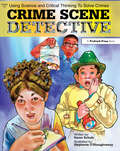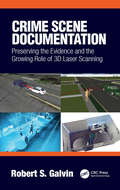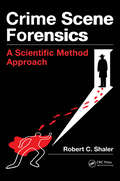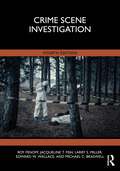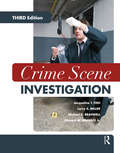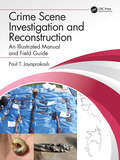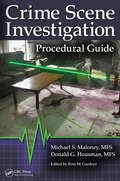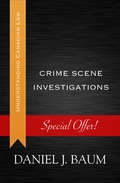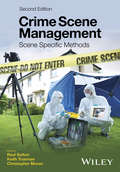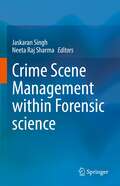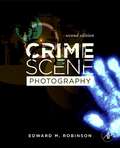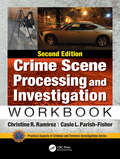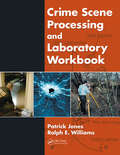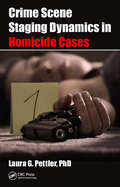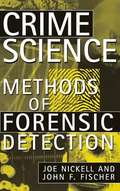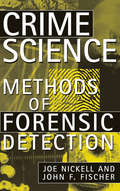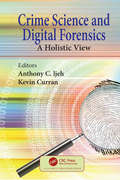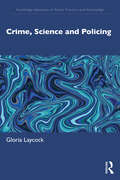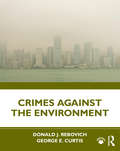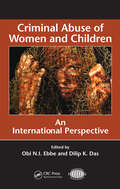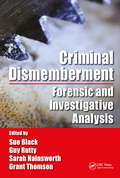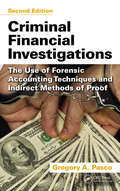- Table View
- List View
Crime Scene Detective: Using Science and Critical Thinking to Solve Crimes (Grades 5-8)
by Karen K. SchulzWatch the excitement ripple through your classroom as students use their intellect to find out who committed the "crime" at your school. Enliven your students as they practice critical thinking skills. Students are often taught skills such as the scientific method, scientific research, critical thinking, making observations, analyzing facts, and drawing conclusions in isolation. Studying forensic science allows students to practice these skills and see theories put into practice by using circumstances that model real-life events, meanwhile letting students explore a variety of career options.This exciting unit includes: background information on forensics, exploration of careers in forensic science and law enforcement, a simulation involving a fire in the school library, and instructions for writing your own crime scene simulation. To crack the case, students examine evidence left at the scene, interview suspects (staff members), and use critical thinking to connect all of the clues and eliminate suspects. Students will feel like real investigators with this true-to-life simulation.Let your students solve more mysteries with Mystery Disease, Mystery Science, Detective Club, and The Great Chocolate Caper.Grades 5-8
Crime Scene Documentation: Preserving the Evidence and the Growing Role of 3D Laser Scanning
by Robert S GalvinWhen a criminal act or vehicle crash occurs, most often a local law enforcement agency responds and is responsible for both investigating the scene and for documenting it. It is critical that scene evidence is collected and recorded efficiently, as the scene can quickly change. The sooner evidence can be collected, reviewed, and analyzed, the better an understanding investigators will have as to how and why the incident occurred. Crime Scene Documentation: Preserving the evidence and the growing role of 3D laser scanning demonstrates at length the value of laser scanning through the use of numerous case studies of investigators who have utilized various 3D technologies and laser scanning to document scenes. Thorough and accurate scene documentation is an essential function at a science and proves particularly valuable in courtroom presentations to help jurors understand a crime or accident’s likely chain of events. The more advanced a scene documentation method is, the better it can be utilized to capture details that will lead to optimal scene diagramming. Currently, 3D laser scanning is the most advanced method of scene documentation available, capturing detailed and realistic digital scans—capturing scenes in their entirety—and yielding a permanent representation of the scene for study and analysis at any time, even years after a crime scene has vanished. The book explains current technology, the latest advances, and how to best utilize the technology. Case examples come from various applications, from tools to programs, can help crash scene investigators understand how scanning can improve scene documentation, provide better and more evidence details, and build more credible diagrams that possibly may be used in court presentations to help support a case. Key Features: Describes 3Dscene recording methods in use and how well they work Outlines the variables and inherent challenges associated with documenting crime and crash scenes Illustrates the positive, and dramatic, impact of having a well-documented scene, particularly in the courtroom Explores how 3D laser scanning has vastly changed the way and extent to which crime and crash scenes can be captured accurately and completely, and subsequently analyzed Explains how laser scanning is highly flexible and presents strategies to integrate it into other crime scene incident recording techniques and technologies Crime Scene Documentation details the many benefits of 3D laser scanning technology relative to its reliability and accuracy as well as the multiple case scenarios in which it can be used. The book serves as an invaluable resource to crime scene technicians, investigators, and reconstructionists on the best ways to document a crime or crash scene.
Crime Scene Forensics: A Scientific Method Approach
by Robert C ShalerBridging the gap between practical crime scene investigation and scientific theory, Crime Scene Forensics: A Scientific Method Approach maintains that crime scene investigations are intensely intellectual exercises that marry scientific and investigative processes. Success in this field requires experience, creative thinking, logic, and the correct
Crime Scene Investigation
by Roy Fenoff Jacqueline T. Fish Larry S. Miller Edward W. Wallace Michael C. BraswellCrime Scene Investigation offers an innovative approach to learning about crime scene investigation, taking the reader from the first response on the crime scene to documenting crime scene evidence and preparing evidence for courtroom presentation. It includes topics not normally covered in other texts, such as forensic anthropology and pathology, entomology, arson and explosives, and the electronic crime scene. Numerous photographs and illustrations complement text material, and a chapter-by-chapter fictional narrative also provides the reader with a qualitative dimension of the crime scene experience.
Crime Scene Investigation: Step By Step From The Crime Scene To The Courtroom
by Larry S. Miller Michael C. Braswell Jacqueline T. Fish Edward W. WallaceCrime Scene Investigation offers an innovative approach to learning about crime scene investigation, taking the reader from the first response on the crime scene to documenting crime scene evidence and preparing evidence for courtroom presentation. It includes topics not normally covered in other texts, such as forensic anthropology and pathology, arson and explosives, and the electronic crime scene. Numerous photographs and illustrations complement text material, and a chapter-by-chapter fictional narrative also provides the reader with a qualitative dimension of the crime scene experience.
Crime Scene Investigation and Reconstruction: An Illustrated Manual and Field Guide
by Paul T. JayaprakashCrime Scene Investigation and Reconstruction: An Illustrated Manual and Field Guide provides methodologies to help investigators to think broadly when seeking out evidence at a scene and, likewise, utilize all the information from a case—especially the observable physical evidence, besides what are collectable, in reconstructing events. In the introductory chapters the author highlights the importance of crime scene reconstruction when answering the question “How something could have happened?” From there, he goes on to explain the principles of exchange, identification, individualization and reconstruction. Here, the “observe-hypothesize” model, proposed in this field-guide, is presented: outlining how every source of information ranging from laboratory reports, opinions from medical doctors, statements of witnesses, and confessions of suspects should be reconcilable with the evidence-based reconstruction made in the crime scene. In this, the author contends that qualified crime scene generalists are the ideal professionals to frame scientific hypothesis and to make reconstructions. Practical recommendations, based on best-practice general crime scene procedures are provided while the second half of the book illustrate and outline how to deal with various types of major crime scenes, including fire deaths, exhuming buried human remains, sexual assaults, death by electrocution, explosion, drowning, poisoning, hanging, and more. Since a picture is a worth thousand words, over 400 collective photographs and sketches are included throughout the book to illustrate the observational methods that are described. In addition, the field-guide provides several easy-to-follow flow-charts to serve as checklists to aid scene investigation in major types of crime scene. In this, Crime Scene Investigation and Reconstruction: An Illustrated Manual and Field Guide will help investigators readily recognize similar manifestations in crime scenes and to apply and use such techniques appropriately in their own work.
Crime Scene Investigation Procedural Guide
by Ross M. Gardner Michael S. Maloney Donald HousmanThose tasked with investigating crime scenes come from a variety of backgrounds and varying levels of experience. Crime Scene Investigation Procedural Guide gives the novice investigator the procedures for almost any crime scene imaginable while providing the seasoned pro a ready reference for crimes occurring even under the most unusual of circums
Crime Scene Investigations
by Daniel J. BaumWhen police are called in to investigate a crime, what powers and limitations apply to them? What are their rights to question strangers, search without warrants, or detain individuals who might become suspects? Crime Scene Investigations breaks down the Supreme Court's decisions on questions like these into clear and practical terms. Police need to be vigilant, since the line between a lawful search and an improper one can be dangerously thin, and officers can be held accountable for any wrongdoing, intentional or not. The controversy surrounding such techniques as "stop-and-frisk" sweeps and compulsory DNA testing underscores the importance of understanding the legal dimensions of police powers. Because interactions between law enforcement officers and civilians are often charged with complexities, Crime Scene Investigations provides a level-headed guide, indispensable for those on either side of an investigation.
Crime Scene Management: Scene Specific Methods
by Raul Sutton Christopher Moran Keith TruemanSecond edition of an established text on common procedures for the identification and processing of evidence at scenes of crime Includes chapters on quality assurance and credibility of practices and processes issues surrounding major and complex crime Forensic handling of mass fatalities Crime scene reconstruction and impact on evidence recovery processes
Crime Scene Management: Scene Specific Methods
by Raul Sutton Keith Trueman Christopher MoranSecond edition of an established text on common procedures for the identification and processing of evidence at scenes of crime Includes chapters on quality assurance and credibility of practices and processes issues surrounding major and complex crime Forensic handling of mass fatalities Crime scene reconstruction and impact on evidence recovery processes
Crime Scene Management within Forensic science
by Neeta Raj Sharma Jaskaran SinghThis book provides deep insight into the significance of various forensic techniques underlying the methodical approaches in criminal investigations. The book comprises numerous case studies, examples, and reference materials. It emphasizes on the better practices for criminal investigations including contemporary examinations. The book also describes various methods for investigation of crime scene and evidence collection including biological evidences to the resources of law enforcement agencies. This book encompasses the procedure for crime scene-documentation through photography, video, and diagrams and highlights the best practices of packaging the biological evidences at a crime scene. Further, it summarizes the role of forensic autopsy to the criminal investigation system. As such, the book is helpful for forensic scientists, medical practitioners, educators and law enforcement personnel.
Crime Scene Management within Forensic Science: Forensic Techniques for Criminal Investigations
by Jaskaran Singh Neeta Raj SharmaThis book, the second volume of Crime Scene Management in Forensic Sciences, reviews the role and impact of forensic evidence in criminal investigations. It also addresses the importance of post mortem examination in criminal cases. The book investigates the use of insects and arthropods to estimate post mortem intervals during forensic investigations. Further, it discusses the physiological effects of xenobiotics at the time of death, based on their concentration and distribution in the body at autopsy. Importantly, it also discusses digital forensic investigation, which can be used for the analysis of digital evidence produced at a court of law. Lastly, it defines the structure and legal framework of these forensic evidences for the effective administration of the criminal justice system. It is an excellent source of information for forensics scientists and legal professionals.
Crime Scene Photography (Second Edition)
by Edward M. RobinsonCrime Scene Photography, Second Edition covers the general principals and concepts of photography, while also delving into the more practical elements and advanced concepts of forensic photography. Edward Robinson assists the reader in understanding and applying essential concepts in order to create images that are able to withstand challenges in court. The first part of the book deals with the basic theory and science of photography required to take superior photographs, and covers topics such as composition, exposure, focus, depth of field, and flash techniques. The second part of the text deals specifically with the challenges of photographing a crime scene, including instructions on how to document bodies and wounds, traffic accident photography, underwater photography and aerial photography. In the latter portions of the text, the author turns to digital theory and its advantages and disadvantages. * Over 600 full color photographs, also electronically available on the companion website * Two new chapters on 'The History of Forensic Photography,' and 'Digital Image Processing of Evidentiary Photography' * Includes an Instructor website with lecture slides, practical exercises, a test bank and image collection * An essential reference for crime scene photography, including topics such as Composition, the Inverse Square Law, Court Cases affecting photography, Digital Image Processing, and Photogrammetry * Required reading by the Crime Scene Certification Board of the International Association for Identification (IAI) for all levels of certification
Crime Scene Processing and Investigation Workbook, Second Edition
by Christine R. Ramirez Casie L. Parish-FisherCrime Scene Processing and Investigation Workbook, Second Edition is the only workbook which directly supports and cross-references methodology and terminology presented in Ross Gardner and Donna Krouskup’s perennial best-seller Practical Crime Scene Processing and Investigations, Third Edition. The workbook serves as supporting material offering hands-on activities to supplement theories and methodologies within the text as well as updated activities to support the new material presented in the Third Edition. As the number of forensic academic programs within the United States continue to grow—and the textbook continues to be a go-to standard in the field—the workbook remains an invaluable reference for academics, forensic training providers, and law enforcement training programs. The detailed Instructor’s Manual (IM) lends itself not only to experts who have utilized these procedures before but also to the novice and student who may be introduced to these topics in a classroom setting for the first time. The workbook conducts over 30 activities with detailed instructions, concept overviews, and reflective post-lab questions. Crime Scene Processing and Investigation Workbook, Second Edition, continues to stand as the best workbook on the market, addressing foundational principles in a hands-on manner while directly correlating to the concepts addressed in the Gardner and Krouskup textbook.
Crime Scene Processing and Laboratory Workbook
by Patrick Jones Ralph E. WilliamsThe most important part of a CSI‘s (crime scene investigator) job is accurate documentation of properly collected evidence. Documentation tells the story of the crime and can ultimately prove a suspect guilty. Through an array of specific exercises and actual document templates used in practice, Crime Scene Processing and Laboratory Workbook teache
Crime Scene Staging Dynamics in Homicide Cases
by Laura Gail PettlerIndividuals who perpetrate murder sometimes pose or reposition victims, weapons, and evidence to make it look like events happened in a different way than what actually transpired. Until now, there has been scarce literature published on crime scene staging.Crime Scene Staging Dynamics in Homicide Cases is the first book to look at this practice, p
Crime Science: Methods of Crime Detection
by Joe Nickell John F. FischThis method is empirical (from the Latin empiricus, "experienced"), meaning that knowledge is gained from direct observation.
Crime Science: Methods of Forensic Detection
by Joe Nickell John F. FischerThis comprehensive guide to forensic investigation &“delivers the goods for the educated layperson . . . readers will be hard-pressed to put it down&” (USA Today). Forensic experts Joe Nickell and John Fischer introduce readers to the work of firearms experts, document examiners, fingerprint technicians, medical examiners, and forensic anthropologists. These topics are explained in clear terms without technical jargon. Nickell and Fisher describe fingerprint classification and autopsies, explain how fibers link victims to their killers, and examine the science underlying DNA profiling and toxicological analysis. From weapons analysis to handwriting samples to shoe and tire impressions, Crime Science outlines the indispensable tools and techniques that investigators use to make sense of a crime scene. Each chapter closes with a study of an infamous case to demonstrate how the principles of forensic science work in practice. Case studies including the O.J. Simpson trial, the Lindbergh kidnapping, the death of Marilyn Monroe, the World Trade Center bombing, the assassination of the Romanovs, and the Atlanta child murders.
Crime Science and Digital Forensics: A Holistic View
by Anthony C. IjehThis volume is a collation of articles on counter forensics practices and digital investigative methods from the perspective of crime science. The book also shares alternative dialogue on information security techniques used to protect data from unauthorised access and manipulation. Scandals such as those at OPCW and Gatwick Airport have reinforced the importance of crime science and the need to take proactive measures rather than a wait and see approach currently used by many organisations. This book proposes a new approach in dealing with cybercrime and unsociable behavior involving remote technologies using a combination of evidence-based disciplines in order to enhance cybersecurity and authorised controls. It starts by providing a rationale for combining selected disciplines to enhance cybersecurity by discussing relevant theories and highlighting the features that strengthen privacy when mixed. The essence of a holistic model is brought about by the challenge facing digital forensic professionals within environments where tested investigative practices are unable to provide satisfactory evidence and security. This book will be of interest to students, digital forensic and cyber security practitioners and policy makers. It marks a new route in the study of combined disciplines to tackle cybercrime using digital investigations and crime science.
Crime, Science and Policing
by Gloria LaycockThis book offers an introduction to crime science; it is specifically for police and security professionals. Written by one of the founders of crime science and an expert in crime reduction, it considers the unique characteristics of the approach, its applicability to the control of crime, disorder and terrorism, and the importance of experimentation and the testing of new ideas to build a knowledge base for ethical policing. Core content includes: The basics of crime science in concept, theory and practice; Methods of research and assessment used by crime scientists; Crime science and policing, including its application to volume crimes, serious crimes and investigation; Legitimacy and public compliance; Policing, science, and future crimes. This book is essential reading for all students of professional policing, as well as those interested in crime and its control, reduction, and prevention.
Crimes Against the Environment
by Donald J. Rebovich George E. CurtisCrimes Against the Environment explains the seriousness of the threat posed by pollution, its roots, how it has evolved, how it differs across the planet, and how society has endeavored to create and enforce laws directed at its control. Rebovich and Curtis begin with an overview of hazardous waste, the industries that produce toxins, available methods of waste treatment, and the legal environment of environmental crime. They examine the forces driving criminal behavior and the methods offenders adopt, as well as protections against polluters and their effectiveness. The book concludes with an examination of environmental justice in the United States and globally, and looks ahead to the future of crime control and prevention in this arena. Case studies and discussion questions offer further perspective on these challenging issues of environmental integrity. This text serves undergraduate or early-stage graduate students majoring in criminal justice, environmental science, sociology, and political science, and could also serve as a resource for professionals in environment-related occupations.
Criminal Abuse of Women and Children: An International Perspective (International Police Executive Symposium Co-Publications)
by Obi N.I. Ebbe Dilip K. DasThe abuse of women and children transcends geographical boundaries as well as economic, cultural, religious, political, and social divisions. Comprised of the work of more than 20 academics and practitioners from around the world, Criminal Abuse of Women and Children documents the atrocities that have been committed against these victims from ancie
Criminal Dismemberment: Forensic and Investigative Analysis
by Sue Black Guy Rutty Sarah V. Hainsworth Grant ThomsonCriminal Dismemberment is the first book to examine dismemberment as a phenomenon in the context of criminal acts. While the number of such dismemberment cases in any given country is often small, the notion of dismemberment captures the imagination, often leading many to question the motivations as to why anyone would perpetrate such an unnatural act. The act of dismemberment, in its original form, referred to cutting, tearing, pulling, wrenching or otherwise separating the limbs from a living being as a form a capital punishment. In today’s society, it has become associated most frequently with the criminal act of sectioning the remains of the dead in an attempt to conceal the death and dispose of the remains or make the process of identification of the deceased more difficult to achieve. Drawing on expertise from leading forensic anthropologists, pathologists, and forensic materials engineers, the book brings together much of the literature on criminal dismemberment—viewing it from the investigative, forensic, and social science perspectives. Key features include: Psychological analysis of the perpetrator Detailed examination of case studies, anonymized from recent investigations Difficulties encountered in a dismemberment investigation Tool mark analysis, including knives and saws, accompanied by over 120 detailed, full-color illustrations and photographs Serves as a unique and useful resource in the investigation of dismembered human remains The diverse backgrounds of the contributors offers a thorough account of such topics as the history of dismemberment, the forensic pathology in such cases, the importance of developing a common vocabulary in terminology used, the legal admissibility in dismemberment cases. As such, Criminal Dismemberment will serve as a comprehensive reference for students and practitioners alike.
Criminal Financial Investigations: The Use of Forensic Accounting Techniques and Indirect Methods of Proof, Second Edition
by Dale L. June Gregory A. PascoUnderstanding the financial motivations behind white collar crime is often the key to the apprehension and successful prosecution of these individuals. Now in its second edition, this volume provides direct instruction on the how to aspects of criminal financial investigations, taking readers through the different approaches used in gathering evidence and demonstrating how to present circumstantial evidence to a judge or jury in a simple and convincing manner. Written by a former Special Agent with the Criminal Investigation Division of the U.S. Internal Revenue Service, the book sets out a methodology enabling readers to identify, pursue, and successfully prosecute white collar crime.
Criminal Investigation: The Art And The Science
by Michael LymanCriminal Investigation: The Art and the Science ― by nationally recognized criminal investigation expert Michael Lyman ― is a clear, thorough examination of the fundamentals of criminal investigation and forensic science, as currently practiced throughout the US. It explores past experiences of investigators alongside forensic and technological innovations. Paralleling the steps of the criminal investigation, the 9th edition has been extensively updated with new and revised material, a new chapter on investigating officer-involved shootings, and updated case studies and graphics.
